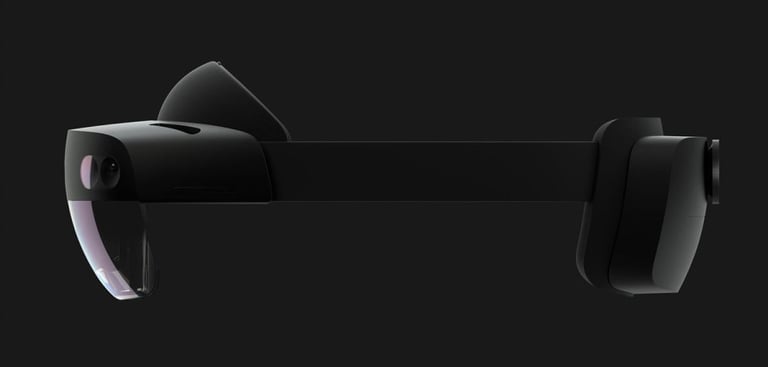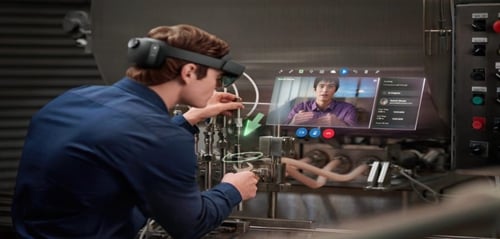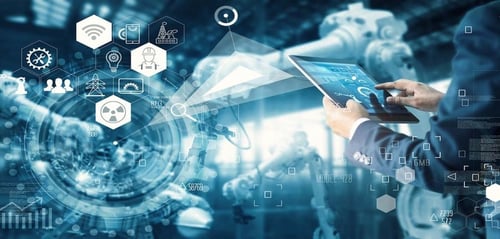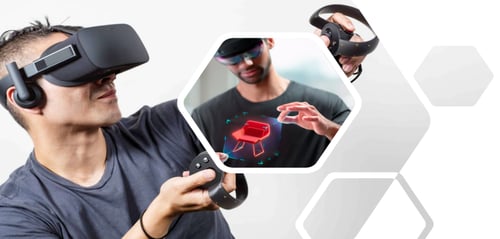Announced in February 2019, HoloLens 2 from Microsoft is finally available for professionals, and it's a small revolution! From ergonomics to eye tracking technology, let's decipher together what this new version of the headset brings.
For those of you who didn't know about Hololens 1, or even Augmented Reality, here's a little reminder. Augmented Reality is an immersive technology that allows, via connected glasses, to superimpose digital elements on a person's field of vision. As an example, at Spectral TMS, we use Augmented Reality to provide visual assistance to operators, in order to facilitate operational work and thus reduce errors and time loss in processes. You can read more about it here.
Until today, the most successful glasses were Microsoft's Hololens 1. However, they have been criticized for being uncomfortable to use, some discomfort for the user and some technical defects. Hololens 2 was therefore eagerly awaited.
Now that everyone is up to date, let's get back to the matter at hand: Hololens 2.
1. Ergonomics rethought: a comfortable tool for industrial operators
The first, and by no means the least important element, is the work done in relation to the comfort of the helmet. Spectral TMS and other companies in the sector had reported problems with the use of the glasses, especially over an extended period of time. We were heard!
HoloLens 2 is better balanced and therefore more comfortable to wear for longer periods of time. You can see from the first seconds of use that in this new version of the glasses, Microsoft has thought of the end user, who barely feels the weight of the glasses on his head.
2. Better screen quality: a bargain for Spectral TMS Remote Assist
The screen of HoloLens 2 offers a definition of almost 2K per eye, with a 52-degree field of view and a total of 47 pixels per degree. In comparison, the previous model offered only 720p per eye with a 30 degree field of view.
In addition, the new helmet-mounted camera allows you to film in 1080p at 30 FPSThis makes videoconferencing, including remote assistance, much more comfortable.
Learn more about Remote Assist : click here
3. Eye tracking: easier handling for operational team
Eye Tracking, as Microsoft calls it, is the technology that allows the headset to follow the user's gaze. Concretely, all you have to do now is look at the buttons you want to click on. It's ergonomic, easy to use, and comfortable. This improvement is part of Microsoft's desire to make Augmented Reality accessible quickly in operational conditions.
On the Spectral TMS side, our customers have shown that operators are more comfortable using the new headset. About thirty minutes are now enough to be perfectly trained on the helmet. This makes it easier to integrate AR in operational conditions in order to optimize business procedure, which removes a lot of friction in all stages of change management.

What it feels like to use the Hololens 2...
You can get our Guide to Augmented Reality in Industry to find out how you can effectively integrate this technology into your processes.
Focus on the most cost-effective applications to successfully implement your Augmented Reality technology.
Ask for your Guide to Industrial AR!
4. Hand Tracking: an extension of the easy picking up
"Hand Tracking", as you will have understood, is the technology with which the helmet will be able to follow the user's hand movements. In other words, the glasses will model your hands in 3D, in real time, to allow you to interact directly with the digital elements, as if you were yourself in the 3D of the glasses. In concrete terms, you will be able to really touch the files present in your scenarios.
Even more concretely, it's as if the different windows of your computer came out of the screen, and you could touch them. That's exactly what it is!
As an extension of Eye Tracking, this improvement also makes it easier and faster for everyone to pick up the headset.
This video gives you a better idea: video
5. Better autonomy for Hololens 2
Finally, HoloLens 2 can boast an autonomy of 7 hours! This autonomy makes it possible to treat all imaginable use cases with the Spectral TMS solution, whatever the conditions.
You want to know more about Augmented Reality in Industry? Get in touch with us now!
Published:
By: Spectral TMS




